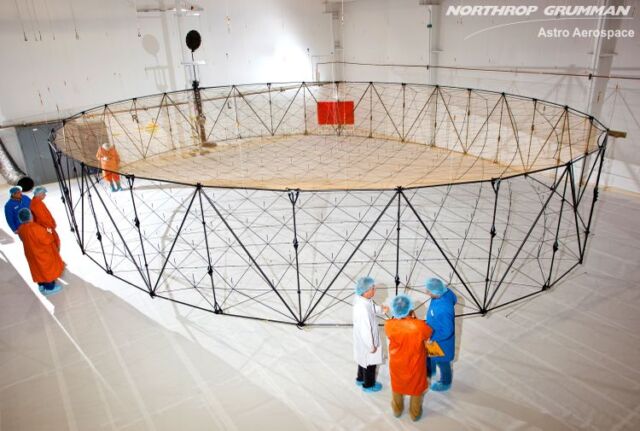
A new Viasat communications satellite launched in April has been crippled by a problem deploying its massive mesh antenna. The issue jeopardizes Viasat’s much-needed revamp of its space-based Internet network, which could help it compete with newer broadband offerings from companies like SpaceX and OneWeb.
Viasat confirmed the antenna problem Wednesday after it was first reported by Space Intel Report. The satellite in question is called ViaSat-3 Americas and was launched April 30 as the primary payload on a SpaceX Falcon Heavy rocket from NASA’s Kennedy Space Center in Florida.
The satellite is one of the most powerful commercial spacecraft ever built, with two solar panel wings the width of a Boeing 767 jetliner capable of generating more than 30 kilowatts of electricity. The solar arrays were deployed shortly after the spacecraft arrived in orbit, and the next step was to deploy a large reflector to bounce Internet signals between the ground and transmitters and receivers aboard the satellite’s main body.
Then the ground controllers got into trouble. During the reflector’s deployment, an “unexpected event” occurred that could “materially affect” the performance of the satellite, Viasat said.
“We are disappointed by the recent developments,” Mark Dankberg, chairman and CEO of Viasat, said in a statement. “We are working closely with the reflector manufacturer to resolve the issue.”
The ViaSat-3 Americas spacecraft remains in contact with ground controllers as they try to resolve the issue. An industry source, speaking on condition of anonymity, told Ars there was very little chance that ground teams would be able to repair the satellite’s antenna and fully restore the mission.
If Viasat declares it a total loss, the ViaSat-3 Americas satellite is insured for $420 million. That would be the largest known insurance claim for the loss of a satellite. But a person familiar with the space insurance market said the $420 million claim would not cover the full cost of the mission. The San Diego Union-Tribune has reported that the ViaSat-3 Americas mission cost about $700 million, leaving Viasat on the hook for the difference.
The aerospace insurance official told Ars that such a claim would be “disruptive” to the industry and could even drive some insurers out of the aerospace market.

The mesh-like reflector antenna on the ViaSat-3 Americas satellite is made of reinforced polymers, graphite and carbon fiber, with fine gold-plated wire woven into the structure to add flexibility and reduce weight. During launch, the antenna folded up against the spacecraft to fit into the rocket’s envelope.
The spacecraft was built by Boeing, with a communications payload developed in-house by Viasat. The reflector was provided by Northrop Grumman’s Astro Aerospace, Dave Ryan, Viasat’s president of space and commercial networks, said in an interview ahead of the April launch.
Ryan said the antenna installation was expected to take “literally days”. The reflector is attached to a boom 80 to 90 feet (about 25 meters) tall, a taller derivative of the mid-booms that aided sunshade placement on the James Webb Space Telescope. Prior to launch, Viasat officials would not reveal the exact specifications of the round parabolic antenna, but said it was one of the largest structures of its kind ever flown in space.
The reflector is needed to focus signals from the satellite to a small location on the ground. It is critical to enable the satellite to reach thousands of users at once, with a total throughput of more than a terabit per second over its 15-year design life.

